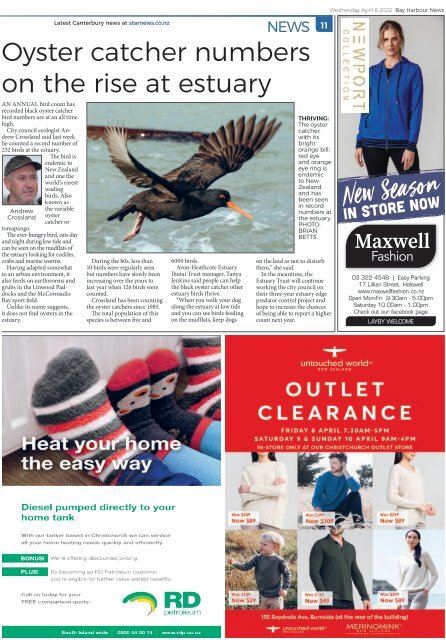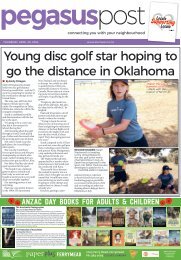Bay Harbour: April 06, 2022
You also want an ePaper? Increase the reach of your titles
YUMPU automatically turns print PDFs into web optimized ePapers that Google loves.
Wednesday <strong>April</strong> 6 <strong>2022</strong> <strong>Bay</strong> <strong>Harbour</strong> News<br />
Latest Canterbury news at starnews.co.nz<br />
NEWS 11<br />
Oyster catcher numbers<br />
on the rise at estuary<br />
AN ANNUAL bird count has<br />
recorded black oyster catcher<br />
bird numbers are at an all time<br />
high.<br />
City council ecologist Andrew<br />
Crossland said last week<br />
he counted a record number of<br />
232 birds at the estuary.<br />
The bird is<br />
endemic to<br />
New Zealand<br />
and one the<br />
world’s rarest<br />
wading<br />
birds. Also<br />
known as<br />
Andrew<br />
Crossland<br />
the variable<br />
oyster<br />
catcher or<br />
toreapango.<br />
The ever-hungry bird, eats day<br />
and night during low tide and<br />
can be seen on the mudflats of<br />
the estuary looking for cockles,<br />
crabs and marine worms.<br />
Having adapted somewhat<br />
to an urban environment, it<br />
also feeds on earthworms and<br />
grubs in the Linwood Paddocks<br />
and the McCormacks<br />
<strong>Bay</strong> sport field.<br />
Unlike its name suggests,<br />
it does not find oysters in the<br />
estuary.<br />
During the 80s, less than<br />
10 birds were regularly seen<br />
but numbers have slowly been<br />
increasing over the years to<br />
last year when 126 birds were<br />
counted.<br />
Crossland has been counting<br />
the oyster catchers since 1985.<br />
The total population of this<br />
species is between five and<br />
6000 birds.<br />
Avon-Heathcote Estuary<br />
Ihutai Trust manager, Tanya<br />
Jenkins said people can help<br />
the black oyster catcher other<br />
estuary birds thrive.<br />
“When you walk your dog<br />
along the estuary at low tide<br />
and you can see birds feeding<br />
on the mudflats, keep dogs<br />
THRIVING:<br />
The oyster<br />
catcher,<br />
with its<br />
bright<br />
orange bill,<br />
red eye<br />
and orange<br />
eye ring is<br />
endemic<br />
to New<br />
Zealand<br />
and has<br />
been seen<br />
in record<br />
numbers at<br />
the estuary.<br />
PHOTO:<br />
BRIAN<br />
BETTS <br />
on the lead as not to disturb<br />
them,” she said.<br />
In the meantime, the<br />
Estuary Trust will continue<br />
working the city council on<br />
their three-year estuary edge<br />
predator control project and<br />
hope to increase the chances<br />
of being able to report a higher<br />
count next year.<br />
New Season<br />
IN STORE NOW<br />
03 322 4548 | Easy Parking<br />
17 Lillian Street, Halswell<br />
www.maxwellfashion.co.nz<br />
Open Mon-Fri 9.30am - 5.00pm<br />
Saturday 10.00am - 1.00pm<br />
Check out our facebook page<br />
LAYBY WELCOME


















